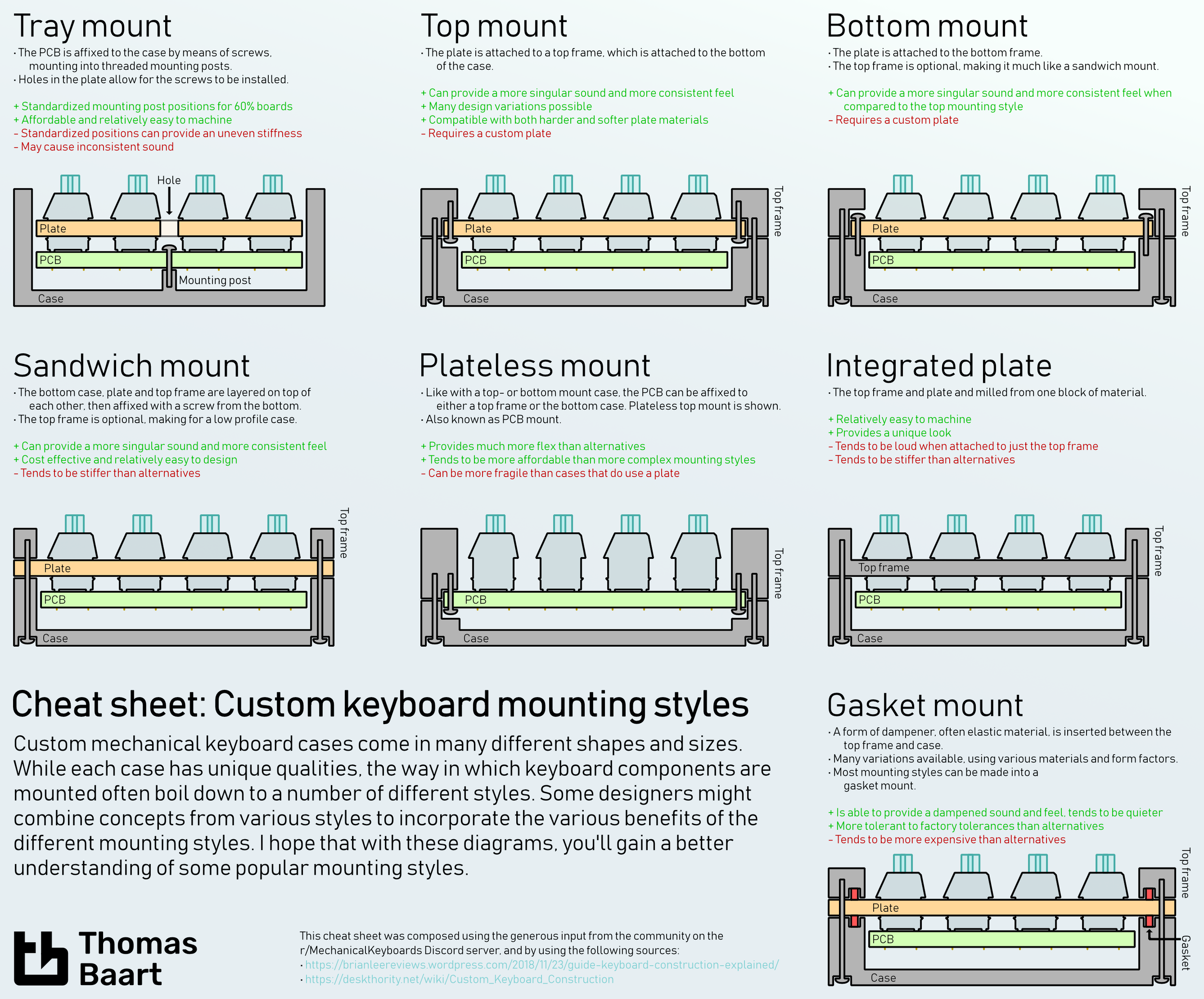Has anyone used a gasket mount keyboard and found that it's better for long-term typing than plate mount keyboards?
Seem like a bunch of snake oil to me. Gasket mount keyboards are a lot more expensive than regular plate mount.
Gasket mount keyboards vs plate mount
-
apastuszak
- Location: Bensalem, PA, USA
- Main keyboard: IBM Model M
- Main mouse: Kensington Slimblade Trackball
- Favorite switch: Buckling Spring
- DT Pro Member: -
- Contact:
-
HungerMechanic
- Location: Canada
- Main keyboard: Filco Majestouch 2
Gasket-mount is getting much cheaper. I'm talking $179 kits, or even $59 kits [available during AliExpress sales].
In fact, gasket-mount has become synonymous with the budget section now.
I have one [IKKI68 Aurora], and yes, they are nice if you are looking for a softer typing experience. Plate mount is stiffer and harsher. So it depends what you are looking for. They are not the be-all-and-end-all. I prefer top-mount for tactile [unsilenced] keyboards.
In fact, gasket-mount has become synonymous with the budget section now.
I have one [IKKI68 Aurora], and yes, they are nice if you are looking for a softer typing experience. Plate mount is stiffer and harsher. So it depends what you are looking for. They are not the be-all-and-end-all. I prefer top-mount for tactile [unsilenced] keyboards.
-
Findecanor
- Location: Stockholm, Sweden
- DT Pro Member: 0011
Eh... OK... I thought that "gasket mount" meant that the plate was mounted with some foam or rubber in-between the plate and the case. Thereby, a gasket mount is a type of plate mount.
Last edited by Findecanor on 27 Nov 2022, 16:38, edited 1 time in total.
-
HungerMechanic
- Location: Canada
- Main keyboard: Filco Majestouch 2
"A gasket mount uses gasket material between the plate and keyboard housing on both top and bottom sides. This gives the board a slightly more cushioned feel since the plate isn’t in direct contact with the other metal components of the keyboard."
https://www.keyboard.university/200-cou ... yles-4lpp7
I don't know much about mounting methods, but the idea behind gasket-mount is that the plate is cushioned somewhat. Some hate it. It seems spongy to them. But I find that it can produce a softer typing feel.
So it's subjective, IMHO, whether it is good or not. My problem is when gasket becomes the de-facto low-end configuration, such that finding an affordable top-mount case becomes difficult. Gasket has eaten the lower-end.
https://www.keyboard.university/200-cou ... yles-4lpp7
I don't know much about mounting methods, but the idea behind gasket-mount is that the plate is cushioned somewhat. Some hate it. It seems spongy to them. But I find that it can produce a softer typing feel.
So it's subjective, IMHO, whether it is good or not. My problem is when gasket becomes the de-facto low-end configuration, such that finding an affordable top-mount case becomes difficult. Gasket has eaten the lower-end.
- Muirium
- µ
- Location: Edinburgh, Scotland
- Main keyboard: HHKB Type-S with Bluetooth by Hasu
- Main mouse: Apple Magic Mouse
- Favorite switch: Gotta Try 'Em All
- DT Pro Member: µ

Back when I was making my own keyboards: “sandwich” specifically meant laser cut metal / acrylic layers, with the top one serving as the plate. A clearer definition, I think; but when you make the infographic you call the shots.
- hellothere
- Location: Mesa, AZ USA
- Main keyboard: Lots
- Main mouse: CST2545W-RC
- Favorite switch: TopreAlpsHallEffectTopreAlpsHallEffectTopreAlps
Quality post.
-
HungerMechanic
- Location: Canada
- Main keyboard: Filco Majestouch 2
People on this forum might be interested in the "Frog TKL."
I don't know if they are still being made, but they're an affordable variation of top-mount, but using rubber pins ["Tadpoles"] that allow you to adjust the stiffness.
So you can make a stiff or kinda-flexy top-mount TKL, using the tadpole-mount system. And the tadpoles are potentially long-lasting, so it could be a real classic board.

Video:
https://youtu.be/h3LJnYP0rc4?t=17
https://youtu.be/mGV9RjKDP5w?t=896
The Frog TKL was generally hard to get, so it's not really an option for most people [even if it is still in aftermarket]. But this kind of creative mounting, creating a truly decent keyboard, is something we need to see more of.
I don't know if they are still being made, but they're an affordable variation of top-mount, but using rubber pins ["Tadpoles"] that allow you to adjust the stiffness.
So you can make a stiff or kinda-flexy top-mount TKL, using the tadpole-mount system. And the tadpoles are potentially long-lasting, so it could be a real classic board.

Video:
https://youtu.be/h3LJnYP0rc4?t=17
https://youtu.be/mGV9RjKDP5w?t=896
The Frog TKL was generally hard to get, so it's not really an option for most people [even if it is still in aftermarket]. But this kind of creative mounting, creating a truly decent keyboard, is something we need to see more of.
-
davkol
- Location: CZ
- Main keyboard: Kinesis Advantage2, JIS ThinkPad,…
- Main mouse: I like (some) trackballs, e.g., L-Trac
- Favorite switch: #vintage ghost Cherry MX Black (+ thick POM caps)
- DT Pro Member: -
I never understood all the hype wrt different plate-mounting designs.
Softer? More flexible? More rigid? … What?
Has anyone ever done proper ABX testing with these keyboards? Because I seriously doubt any such thing can be noticeable, based on the Weber–Fechner law. Considering the force necessary to actuate a keyboard switch and the fact that the user first taps the keycap and in turn compresses switch spring/dome, how much goes into the plate itself and how is it perceivable?
I'll grant that there are some flimsy keyboards, usually full-size with a poorly supported PCB and plastic or no plate. For example, newer Cherry G80-3000 or certain versions of NTC KB-6251. Those are not the subject of this discussion though.
I suppose there might be a significant difference in acoustics, how the noise is distributed, although the mounting method would likely still be a relatively minor factor compared to plate material, thickness or even existence in the first place. But then I suspect the purported effect on key feel is a function of psychoacoustics.
Softer? More flexible? More rigid? … What?
Has anyone ever done proper ABX testing with these keyboards? Because I seriously doubt any such thing can be noticeable, based on the Weber–Fechner law. Considering the force necessary to actuate a keyboard switch and the fact that the user first taps the keycap and in turn compresses switch spring/dome, how much goes into the plate itself and how is it perceivable?
I'll grant that there are some flimsy keyboards, usually full-size with a poorly supported PCB and plastic or no plate. For example, newer Cherry G80-3000 or certain versions of NTC KB-6251. Those are not the subject of this discussion though.
I suppose there might be a significant difference in acoustics, how the noise is distributed, although the mounting method would likely still be a relatively minor factor compared to plate material, thickness or even existence in the first place. But then I suspect the purported effect on key feel is a function of psychoacoustics.
- browncow
- Location: Poland
- Main keyboard: Chicony 5161 - blue alps
- Main mouse: microsoft ime3.0
- Favorite switch: Futaba MA
I think it has to do with bottoming out and with linear switches, you will be doing that a lot. Considering most popular modern switches are linear, having something to "cushion" a heavy bottom out when you are typing too hard on linears, might reduce fatigue a bit. However any kind of sponginess or "softness" in the keyboard itself sounds absolutely unwanted to me when you use tactile switches, where the main point of the design is to give the user some sort of feedback, other than bottoming the switch out. So i think that whole gasket thing is making sense when you type REALLY HARD. then you can feel the sponginess of the keyboard as something positive and reducing fatigue. Having used both linear and tactile switches i always type much harder on linears.davkol wrote: ↑28 Nov 2022, 14:57I never understood all the hype wrt different plate-mounting designs.
Softer? More flexible? More rigid? … What?
Has anyone ever done proper ABX testing with these keyboards? Because I seriously doubt any such thing can be noticeable, based on the Weber–Fechner law. Considering the force necessary to actuate a keyboard switch and the fact that the user first taps the keycap and in turn compresses switch spring/dome, how much goes into the plate itself and how is it perceivable?
I'll grant that there are some flimsy keyboards, usually full-size with a poorly supported PCB and plastic or no plate. For example, newer Cherry G80-3000 or certain versions of NTC KB-6251. Those are not the subject of this discussion though.
I suppose there might be a significant difference in acoustics, how the noise is distributed, although the mounting method would likely still be a relatively minor factor compared to plate material, thickness or even existence in the first place. But then I suspect the purported effect on key feel is a function of psychoacoustics.
I have an idea though, why not for ultimate softness hang the plate on some really stiff horizontal springs? like a hammock
-
davkol
- Location: CZ
- Main keyboard: Kinesis Advantage2, JIS ThinkPad,…
- Main mouse: I like (some) trackballs, e.g., L-Trac
- Favorite switch: #vintage ghost Cherry MX Black (+ thick POM caps)
- DT Pro Member: -
That's absurd.browncow wrote: ↑28 Nov 2022, 16:35I think it has to do with bottoming out and with linear switches, you will be doing that a lot. Considering most popular modern switches are linear, having something to "cushion" a heavy bottom out when you are typing too hard on linears, might reduce fatigue a bit.
If someone hammers keys so hard, they need stiffer springs. It also defeats the point of lubrication and the entire obsession with stem smoothness, because of the aforementioned Weber–Fechner law.
I got my first keyboard with Cherry MX Red a decade ago, because I wanted to experience the cloud of boobs effect—most certainly not bottoming out hard. Later I proceeded to use so-called ghost blacks, i.e., linears with a steep force curve to dampen post-actuation travel, and currently hoard sprit's "progressive" springs.
I understand that some people prefer the opposite, hence popularity of Gateron Yellow with its almost flat force curve, but I'd like to see the ABX tests regardless, for reasons stated earlier.
-
Findecanor
- Location: Stockholm, Sweden
- DT Pro Member: 0011
I think having moderately soft gaskets can make sense even in a board with tactile switches — for sound damping.browncow wrote: ↑28 Nov 2022, 16:35I think it has to do with bottoming out and with linear switches, you will be doing that a lot. Considering most popular modern switches are linear, having something to "cushion" a heavy bottom out when you are typing too hard on linears, might reduce fatigue a bit. However any kind of sponginess or "softness" in the keyboard itself sounds absolutely unwanted to me when you use tactile switches, where the main point of the design is to give the user some sort of feedback, other than bottoming the switch out.
But then there are "flex-cuts" and stuff that make the actual plate and even the PCB itself springy, sometimes in combination with soft gaskets.
But those two are not really the same thing.
They need to learn to appreciate Cherry MX Clear with the stock springs!
Tactility + cushioning after actuation, once you've learned how to type on them !